

ETH - UP - Ocean Biogeochemical Dynamics. Textbook.
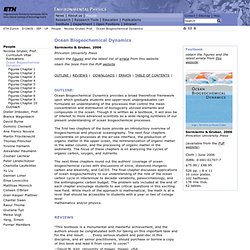
Deep Hypersaline Anoxic Basins (DHABs) : The Halocline. Click to enlarge Border Between Two Worlds—and a World of Its Own One of the most interesting features of DHABs is the zone where they meet the normal seawater above them.
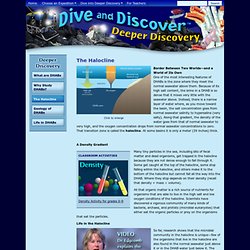
Because of its high salt content, the brine in a DHAB is so dense that it mixes very little with the seawater above. Instead, there is a narrow layer of water where, as you move toward the basin, the salt concentration goes from normal seawater salinity to hypersaline (very salty). Along that gradient, the density of the water goes from that of normal seawater to very high, and the oxygen concentration drops from normal seawater concentrations to zero. That transition zone is called the halocline. A Density Gradient. Thermal maximums. Ocean Conveyor's 'Pump' Switches Back On. By Lonny Lippsett :: Originally published online : In print Vol. 47, No. 2, Sep. 2009.
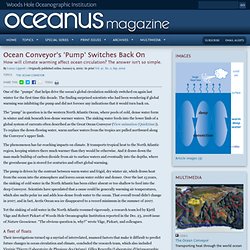
Ocean processes of climatic importance in the Arctic. The marine Arctic plays an important role in the global climate system (Box 9.1).

Momentous discoveries in oceanography. Earlier this month, one of our network bloggers, Matt Herod, put out a call for posts on momentous discoveries in geology as part of a well-known geoscience blog carnival, The Accretionary Wedge.
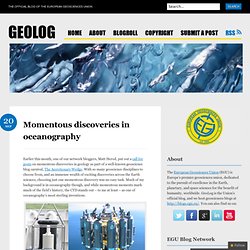
With so many geoscience disciplines to choose from, and an immense wealth of exciting discoveries across the Earth sciences, choosing just one momentous discovery was no easy task. Much of my background is in oceanography though, and while momentous moments mark much of the field’s history, the CTD stands out – to me at least – as one of oceanography’s most sterling inventions. This is a CTD (left). Often deployed off research ships with a large bundle of sampling bottles known as a rosette (right), CTDs record the conductivity (and hence, salinity), temperature and depth of water in the ocean, allowing physical oceanographers to get a good look at it’s structure and work out which water masses are moving where.
Salty Seas. Salt Salt (sodium chloride [NaCl]) tends to form solid blocks, or crystals, at room temperature.

When bonded in this way, the sodium part of the salt (or "ion") takes on a positive charge, and the chloride ion takes on a negative charge. This sets the stage for water (also a polar molecule) to pull it apart or dissolve it. Stir a spoonful of sugar in water and watch it dissolve. You have just created a solution, constituted by molecules of two substances evenly dispersed among each other. In this example, water acts as the solvent. Water is a good solvent (because many substances can dissolve into water, it is sometimes called the "universal solvent"), partly due to the fact that it is a polar molecule. UCSB Scientists Document Fate of Huge Oil Slicks From Seeps at Coal Oil Point. Link to original press release (Santa Barbara, Calif.) –– Twenty years ago, the oil tanker Exxon Valdez was exiting Alaska's Prince William Sound when it struck a reef in the middle of the night.
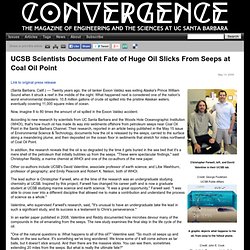
What happened next is considered one of the nation's worst environmental disasters: 10.8 million gallons of crude oil spilled into the pristine Alaskan waters, eventually covering 11,000 square miles of ocean. Now, imagine 8 to 80 times the amount of oil spilled in the Exxon Valdez accident. According to new research by scientists from UC Santa Barbara and the Woods Hole Oceanographic Institution (WHOI), that's how much oil has made its way into sediments offshore from petroleum seeps near Coal Oil Point in the Santa Barbara Channel. Oceans of the world. Deep Atlantic Circulation During the Last Glacial Maximum and Deglaciation. G115 - Introduction to Oceanography. Lecture The three-cell model of atmospheric circulation creates the major wind belts of the world.

Boundaries between wind belts and surface atmospheric pressures are also shown. The general pattern of wind belts is modified by seasonal changes and the distribution of continents. (Source: Pearson Prentice Hall) Institute of Climate Studies, USA - October 2013 - Heat Transport to the Arctic and Corresponding Changes in Climate and Ecology. Heat Transport to the Arctic and Corresponding Changes in Climate and Ecology Put a cold spoon in a hot cup of coffee and what happens?
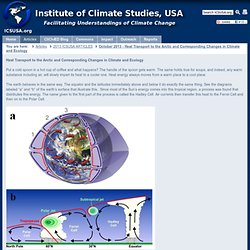
The handle of the spoon gets warm. The same holds true for soups, and indeed, any warm substance including air, will slowly impart its heat to a cooler one. Heat energy always moves from a warm place to a cool place. Ocean acidification (biochemistry) Ocean acidification, the worldwide reduction in the pH of seawater as a consequence of the absorption of large amounts of carbon dioxide (CO2) by the oceans.
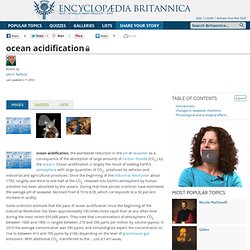
Ocean acidification is largely the result of loading Earth’s atmosphere with large quantities of CO2, produced by vehicles and industrial and agricultural processes. Since the beginning of the Industrial Revolution about 1750, roughly one-third to one-half of the CO2 released into Earth’s atmosphere by human activities has been absorbed by the oceans. During that time period, scientists have estimated, the average pH of seawater declined from 8.19 to 8.05, which corresponds to a 30 percent increase in acidity.
NOAA PIFSC - Ocean Acidification. What is ocean acidification? Chemical dynamics of atmospheric carbon dioxide combining with ocean water. Image courtesy of Phil Munday of James Cook University. Ocean acidification is the changing of the carbonate chemistry of Earth's oceans due to absorption of carbon dioxide (CO2). About 30% of atmospheric CO2 is absorbed by the world's oceans. This absorption is changing their delicate chemical balance, making it difficult for calcifying organisms, such as corals, molluscs, and shellfishes, to produce their carbonate skeletons. FOR EDUCATORS. Online Professional Development PBS TeacherLine, the premier provider of online professional development services for PreK-12 educators, has the goal of making professional development accessible, affordable and engaging for teachers.
Our hope is that our courses can help inspire and guide STEM learning at every age and in every discipline. "PBS TeacherLine not only offers me current, researched information, but the lessons are immediately usable, and transferable into my own classroom. "- Elementary School Teacher, Albuquerque, NM For more, visit www.pbs.org/teacherline. Geophysical Fluid Dynamics Laboratory - Atmospheric Processes. The Ocean and Climate. The Ocean and Climate We are not merely inhabitants of a planet, adapting ourselves to it. Life has verily constructed the planet. It would not behave as it does, even in its deep interior, were it not for life. GEOL B10 Lecture #28 - Fall 2013. Image : Ocean Atmosphere Exchange : Ocean Atmosphere Exchange : Ocean Observatories Initiative. Atmospheric Circulation. Atmosphere: Circulation. There are both global and local circulations of the air around us.
Scientists have different terms for the circulation based on how large the air movements are. They say macroscale to describe wind currents that are on a global scale. Mesoscale describes storms like thunderstorms or blizzards. There are also winds and small circulations that only last for a few seconds. These smaller circulations are described with the term microscale. Let's talk about local winds first. Atmospheric Pressure Makes The Wind Blow. Global Atmospheric Circulation Model video. Blue Carbon - A new key to help combat climate change. Geog 207 Lec 1 images. Systems, open and closed A group of interacting, interrelated, or interdependent elements forming a complex whole A naturally occurring group of objects or phenomena: the solar system Includes defined boundaries: OPEN: matter and /or energy can pass in and out across boundaries CLOSED: No matter or energy can pass into or out of the system Examples?
Energy and materials, matter? Untitled. The Habitable Planet Unit 2 - Atmosphere // Online Textbook. Atmospheric circulation is set up when mass moves in the atmosphere. This motion may be vertical, as when warm air rises and becomes buoyant. Atmospheric Circulation. Ocean_and_wind_currents. What causes ocean currents? Ocean circulation. OCE3014_Lec11_CH7. Wind and Surface Ocean Current Circulation - Water. Chap10. Discerning Humanity’s Imprint on Rainfall Patterns. IT’S the perfect storm.
At a time when global demand for water is rising rapidly due to population growth, urbanization, industrial activities, and expanded use of crop irrigation systems, climate change may be altering the timing, location, and amount of rain and snow that fall on large swaths of the planet. Computational models indicate that increases in global surface temperatures will redistribute rainfall in two ways. First, warmer air, which holds more water vapor, will intensify existing precipitation and drought conditions.
That is, more rain will fall in wet areas, and evaporation will increase in drier areas. Second, shifts in atmospheric circulation patterns will push storm paths and subtropical dry zones toward the poles. Satellite records for the past few decades show that rainfall patterns worldwide are changing. Antarctic Circumpolar Current. The Last Interglacial Part Four - Oceanic Influences. HotWhopper: Perennially Puzzled Bob Tisdale knows zilch about ocean heat... Ocean Conveyor Belt Dismissed. Climate Change Research Centre (CCRC) - University of New South Wales - Australia. Currents and circulation (2) Wind and Pressure. Oceanic Currents and Circulation.
Ekman transport. The GEOL 3030 Summary exercise. Essentials of Weather DLESE Teaching Box. The Science of Abrupt Climate Change. Atmosphere Key Concepts. Earth 540: Essentials of Oceanography for Educators. Atlantic meridional overturning circulation. Thermohaline Circulation - Fact Sheet by Stefan Rahmstorf. Great ocean currents « World Ocean Review. Thermohaline circulation. Atmospheric circulation. Satellite Applications for Geoscience Education.
The Global Climate System.